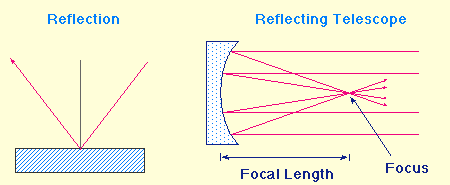 |
| Principle of reflection and the reflecting telescope |
| Reflecting Telescopes and Telescope Powers |
In the preceding section we saw how to use refraction by lenses to design a telescope. We may also use reflection from mirrors to accomplish the same purpose.
 |
| Principle of reflection and the reflecting telescope |
For technical reasons, the largest optical telescopes are reflecting rather than refracting telescopes: it is easier to build and support large mirrors of high optical quality than large lenses.
Note that there are 3 ways in which telescopes help us. They can make images brighter (collecting area), they can make them more detailed, (resolution) and they can make them larger (magnification).
Light gather power describes how much light a telescope can collect. This is directly related to the area of their OBJECTIVES (= the primary mirror for a refracting telescope or the primary lens for a reflecting telescope). The area is proportional to the square of the diameter, so we have the ratio of LIGHT GATHERING POWER between two telescopes a and b to be
The second power of telescopes is the RESOLVING POWER. This describes how effectively a telescope can measure fine detail. Since light acts as a wave, as described earlier, it produces a DIFFRACTION FRINGE around each point in the image and we cannot see any detail smaller than the fringe. The larger a telescope (i.e. the larger the OBJECTIVE) the smaller the fringe and the smaller the fringe and the better the resolving power. The resolving power is proportional to the wavelength divided by the telescope's diameter. For optical wavelengths, the resolving power in arc seconds is
It is important to note that the lens quality and the atmospheric conditions play an important role in a telescope's ability to resolve: The lenses and mirrors cannot have imperfections. In addition, because the air in the atmosphere is "turbulent" that is has a lot of random motions, light passing though this suffers random deflections and slight blurring. (This is why the stars twinkle.) On a night when the images are blurred we say that the SEEING is bad. When the images are not blurred we say the SEEING is good. Mostly it is the seeing which limits the resolution of big telescopes.
The third power of telescopes is called MAGNIFICATION POWER and is the ability of the telescope to make the image larger. It is determined by the ratio of the FOCAL LENGTH of the OBJECTIVE to the FOCAL LENGTH of the eyepiece
The reason optical telescopes are built on mountains is to get the best possible seeing, where the air is thinner and less turbulent, and also to avoid light pollution from city lights which make it difficult to see dim objects.
To use the "information" telescopes collect in the form of light, one needs to have instruments that actually record that information. IMAGING (recording the "picture" of objects) was done on photographic plates. Now it is done on CCDs (Charged Coupled Devices). These are essentially electronic photographic plates whereby the amount of photons stimulates a reaction that produces charged particles. The information is imprinted and stored directly in the form of numbers which go into a computer and are then processed for analysis.
SPECTRAL ANALYSIS is the study of the shape of the spectrum coming from an object and to see this the light has to be separated according to its wavelength. We discussed this earlier in the context of a prism and a diffraction grating. Diffraction gratings are used to produce the spectra in sophisticated modern telescopes.